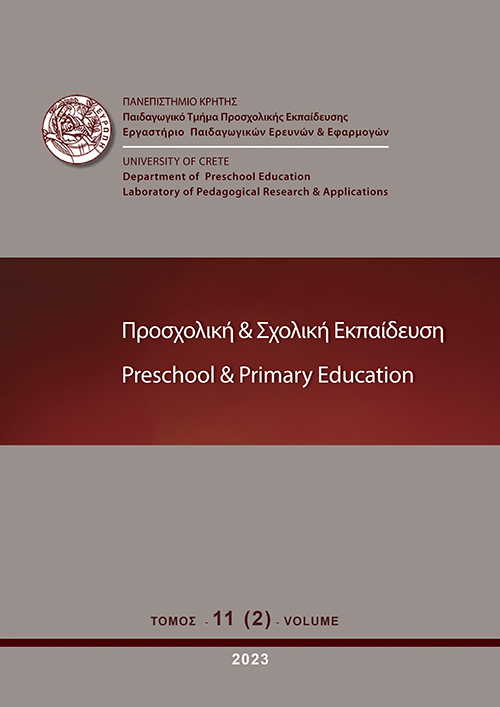The impact of a therapy dog program on children’s with ASD social skills, communication, and behavioral difficulties

Περίληψη
Σύγχρονα ερευνητικά δεδομένα επιβεβαιώνουν το διαμεσολαβητικλο ρόλο των ζώων, και ειδικά των σκύλων, μεταξύ παιδιού και θεραπευτή. Η παρουσία του σκύλου ΄έχει διερευνηθεί μέσα από κλινικές μελέτες. Στην περίπτωση των παιδιών με αναπηρίες διευκολύνει τη θεραπευτική πράξη καθώς αποσπά την προσοχή τους από τα πραγματικά τους προβλήματα και τα βοηθάει να αισθανθούν άνετα. Ωστόσο, εντοπίζεται ένα ερευνητικό κενό στην επίδραση που έχει η παρουσία ενός θεραπευτικού σκύλου στο σχολικό περιβάλλον. Σκοπός της παρούσας μελέτης είναι να διερευνήσει την αποτελεσματικότητα της παρουσίας του σκύλου στο πλαίσιο ενός προγράμματος παρέμβασης για μαθητές με Διαταραχή Αυτιστικού Φάσματος (ΔΑΦ). Στην έρευνα συμμετείχαν τρεις μαθητές δημοτικού σχολείου με ΔΑΦ, οι δάσκαλοι και οι γονείς τους. Η συλλογή δεδομένων βασίστηκε στην παρατήρηση από τους δασκάλους και τους γονείς των κοινωνικών αποκρίσεων των μαθητών και των προβλημάτων συμπεριφοράς πριν και μετά την παρέμβαση, στο ημερολόγιο των δασκάλων καθώς και στη μικρο-ανάλυση των έξι θεραπευτιικών συνεδρι΄΄ων στο χώρο του σχολείου. Τα αποτελέσματα έδειξαν ότι η παρουσία του σκύλου ενισχύει την ανταπόκριση των μαθητ΄΄ων στα κοινωνικά ερεθίσματα και μειώνει τα συμπτώματα της ΔΑΦ, όχι μόνο κατά τη διάρκεια της παρέμβασης αλλά και μετά το πέρας της. Κατά τη διάρκεια των συνεδριών δεν παρατηρ΄΄ηθηκαν επιθετικές συμπεριφορές ή αυτοτραυματισμοί. Η μελέτη αναδεικνύει τα οφέλη της παρουσίας ενός ζώου στη θεραπευτικη πράξη στο σχολικό περιβάλλον.
Λεπτομέρειες άρθρου
- Πώς να δημιουργήσετε Αναφορές
-
Καρπουτζάκη Χ., Μαρκοδημητράκη Μ., Κυπριωτάκη Μ., & Χαριτάκη Γ. (2023). The impact of a therapy dog program on children’s with ASD social skills, communication, and behavioral difficulties. Preschool and Primary Education, 11(2), 284–317. https://doi.org/10.12681/ppej.32430
- Ενότητα
- Άρθρα

Αυτή η εργασία είναι αδειοδοτημένη υπό το CC Αναφορά Δημιουργού – Μη Εμπορική Χρήση – Παρόμοια Διανομή 4.0.
Οι συγγραφείς των άρθρων που δημοσιεύονται στο ΠΡΟΣΧΟΛΙΚΗ & ΣΧΟΛΙΚΗ ΕΚΠΑΙΔΕΥΣΗ διατηρούν τα δικαιώματα πνευματικής ιδιοκτησίας επί των άρθρων τους, δίνοντας στο περιοδικό το δικαίωμα της πρώτης δημοσίευσης. Άρθρα που δημοσιεύονται στο ΠΡΟΣΧΟΛΙΚΗ & ΣΧΟΛΙΚΗ ΕΚΠΑΙΔΕΥΣΗ διατίθενται με άδεια Creative Commons 3.0 και σύμφωνα με την άδεια μπορούν να χρησιμοποιούνται ελεύθερα, με αναφορά στο/στη συγγραφέα και στην πρώτη δημοσίευση για μη κερδοσκοπικούς σκοπούς και με δικαίωμα τροποποίησης μόνον με παρόμοια διανομή (αν αναμείξετε, τροποποιήσετε, ή δημιουργήσετε πάνω στο υλικό, πρέπει να διανείμετε τις δικές σας συνεισφορές υπό την ίδια άδεια όπως και το πρωτότυπο). To Εργαστήριο Παιδαγωγικών Ερευνών και Εφαρμογών του Παιδαγωγικού Τμήματος Προσχολικής Εκπαίδευσης του Πανεπιστημίου Κρήτης και το Εθνικό Κέντρο Τεκμηρίωσης διατηρούν το δικαίωμα να δημοσιεύουν, να αναπαραγάγουν, να παρουσιάζουν στο κοινό, να διανέμουν και χρησιμοποιούν άρθρα που δημοσιεύονται στο ΠΡΟΣΧΟΛΙΚΗ & ΣΧΟΛΙΚΗ ΕΚΠΑΙΔΕΥΣΗ σε οποιοδήποτε μέσο και μορφή είτε μεμονωμένα είτε ως μέρη συλλογικών έργων, για όλο το χρόνο διάρκειας προστασίας της πνευματικής ιδιοκτησίας και για όλες τις χώρες του κόσμου. Αυτό περιλαμβάνει ενδεικτικά και όχι αποκλειστικά, το δικαίωμα δημοσίευσης των άρθρων σε τεύχη του περιοδικού ΠΡΟΣΧΟΛΙΚΗ & ΣΧΟΛΙΚΗ ΕΚΠΑΙΔΕΥΣΗ, αναπαραγωγής και διανομής μεμονωμένων αντιγράφων των άρθρων, αναπαραγωγής ολόκληρων των άρθρων σε άλλη έκδοση του Εργαστηρίου Παιδαγωγικών Ερευνών και Εφαρμογών του Παιδαγωγικού Τμήματος Προσχολικής Εκπαίδευσης του Πανεπιστημίου Κρήτης και του Εθνικού Κέντρου Τεκμηρίωσης και αναπαραγωγής και διανομής των άρθρων ή περίληψης αυτών με χρήση πληροφορικού συστήματος αποθετηρίου.


